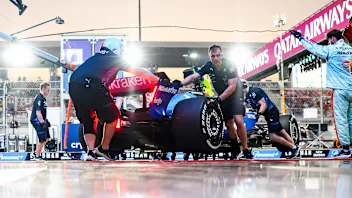It was in a fit of rage, so the story goes, that Enzo Ferrari abandoned the Ferrari red in 1964, swearing that his team would never again race in Italy's national colours. As it was, his threat would prove short-lived. But whether he was bluffing or not, the Prancing Horse did indeed use a different livery for the final two Grands Prix of that season - races that would come to define one of Formula One racing's most celebrated legends...

Political manoeuvring, and a dispute over regulations, were at the heart of the fallout
As with so many sporting fallouts in history, politics - and arguments over regulations - were at the heart of the matter.
The bad blood between Ferrari, the FIA and Italy's national motorsport body (the ACI) was believed to date back to 1962, when Ferrari wanted to homologate their 250 GTO to compete in GT racing. According to the Italian rules of the time, 100 road-going models of a car had to be built before it was eligible to race. The story goes that Ferrari were short of the tally, but had a trick or two up their sleeves...
According to popular legend, Enzo Ferrari was able to pull the wool over the eyes of the FIA by taking representatives to see a small group of GTOs in one area, then ushering them in for a cordial coffee, before taking them off to see other batches in another area. In total, the FIA counted enough cars to be satisfied. There was just one issue - Ferrari had moved the same cars to different locations...
How much of that is myth and how much is reality is open to debate, but it might explain why in 1964, when Ferrari wanted to homologate a new car, the 250 LM, the FIA denied them eligibility. The governing body could not see Ferrari building the requisite 100 cars, and were reportedly less open to persuasion due to past events.
If that drew Enzo's anger, the ACI's decision to not back Ferrari in the argument sent him into frenzy.

Still racing in white and blue, Surtees came through to finish second in Mexico - sealing a historic world championship
He handed in his competitor's licence, and promised never to race in red again. It was a stunning declaration. At the time, teams used national colours rather than independent liveries. Visually at least, Enzo was severing the ties between Ferrari and Italy.
The United States Grand Prix at Watkins Glen - the penultimate race of the season - was the first opportunity to witness the consequences.
Officially there were no works Ferraris entered, but for all intents and purposes the Scuderia had not really withdrawn. Instead championship challenger John Surtees and team mate Lorenzo Bandini were suddenly entered under a new banner: the North American Racing Team. Operated by former racer Luigi Chinetti - an importer helping to put the Prancing Horse on the map in North America - NART were essentially a Ferrari satellite operation who had achieved significant sportscar success on American soil.
For the drivers very little would change: Surtees would still race his familiar 158 - it would just be adorned in the blue and white of the United States rather than the familiar red of Italy.
The Briton was second in the new colour scheme at The Glen, and with the dispute still rumbling on, he would race with it again at the all-important season finale in Mexico. It was a Grand Prix that would go down in history - with fortune on his side, Surtees came through to finish second - and in doing so sealed the 1964 crown.
Surtees became the first - and to date only - champion on two and four wheels, and also the first Ferrari driver to claim an F1 title in blue - an utterly unique feat on two levels.
Main image: © LAT Photographic
Next Up



.webp)
.webp)
.webp)